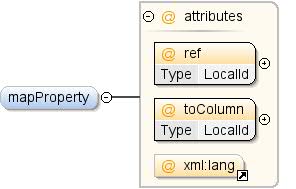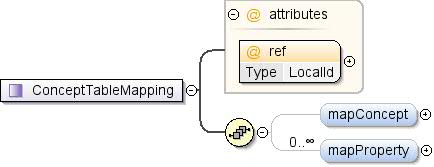कॉम्पोनेंट: ConceptTableMapping
संग्रह की मदद से व्यवस्थित रहें
अपनी प्राथमिकताओं के आधार पर, कॉन्टेंट को सेव करें और कैटगरी में बांटें.
| नाम-स्थान |
http://schemas.google.com/dspl/2010 |
| एनोटेशन |
उस टेबल कॉलम के आईडी के लिए मैपिंग जिसमें
के मान हैं. अगर टेबल कॉलम में कॉलम की संख्या दिखती है, तो इस मैपिंग को हटाया जा सकता है
इसमें कॉन्सेप्ट वैल्यू शामिल होती है और उसका आईडी, कॉन्सेप्ट वैल्यू से मेल खाता है
आईडी. |
| डायग्राम |
 |
| प्रॉपर्टी |
| सामग्री: |
जटिल |
| मिनट समय: |
0 |
|
| विशेषताएं |
| QName |
टाइप |
तय |
डिफ़ॉल्ट |
इस्तेमाल करें |
टिप्पणी |
| toColumn |
LocalId |
|
|
ज़रूरी है |
मैप किए गए टेबल कॉलम का आईडी. |
|
| स्रोत |
<xs:element name="mapConcept" minOccurs="0">
<xs:annotation>
<xs:documentation>A mapping to the id of the table column that contains the
values of the concept. This mapping may be omitted if the
table column that contains the concept values has the same
id as the concept id.</xs:documentation>
</xs:annotation>
<xs:complexType>
<xs:attribute name="toColumn" type="LocalId" use="required">
<xs:annotation>
<xs:documentation>The id of the mapped table column.</xs:documentation>
</xs:annotation>
</xs:attribute>
</xs:complexType>
</xs:element>
|
| नाम-स्थान |
http://schemas.google.com/dspl/2010 |
| एनोटेशन |
उस टेबल कॉलम के आईडी के लिए मैपिंग जिसमें
कॉन्सेप्ट की प्रॉपर्टी की वैल्यू भी शामिल करें. इस मैपिंग को तब छोड़ा जा सकता है, जब
टेबल कॉलम में, कॉन्सेप्ट प्रॉपर्टी की वैल्यू वाले टेबल कॉलम में प्रॉपर्टी होती है
id को आईडी के रूप में शामिल करें. एक प्रॉपर्टी को कई टेबल कॉलम में मैप किया जा सकता है
(हर भाषा के लिए एक) भाषा के लिए अलग-अलग वैल्यू तय करके
एट्रिब्यूट. |
| डायग्राम |
 |
| प्रॉपर्टी |
| सामग्री: |
जटिल |
| मिनट समय: |
0 |
| maxOccurs: |
अनबाउंड |
|
| विशेषताएं |
| QName |
टाइप |
तय |
डिफ़ॉल्ट |
इस्तेमाल करें |
टिप्पणी |
| lang |
|
|
|
ज़रूरी नहीं |
|
| रेफ़रंस |
LocalId |
|
|
ज़रूरी है |
मैप की गई कॉन्सेप्ट प्रॉपर्टी का आईडी. |
| toColumn |
LocalId |
|
|
ज़रूरी है |
मैप किए गए टेबल कॉलम का आईडी. |
|
| स्रोत |
<xs:element name="mapProperty" minOccurs="0" maxOccurs="unbounded">
<xs:annotation>
<xs:documentation>A mapping to the id of the table column that contains the
values of a property of the concept. This mapping may be
omitted if the table column that contains the concept
property values has the property id as its id.
A single property can be mapped to multiple table columns
(one per language) by specifying different values for the
language attribute.</xs:documentation>
</xs:annotation>
<xs:complexType>
<xs:attribute name="ref" type="LocalId" use="required">
<xs:annotation>
<xs:documentation>The id of the mapped concept property.</xs:documentation>
</xs:annotation>
</xs:attribute>
<xs:attribute name="toColumn" type="LocalId" use="required">
<xs:annotation>
<xs:documentation>The id of the mapped table column.</xs:documentation>
</xs:annotation>
</xs:attribute>
<xs:attribute ref="xml:lang" use="optional">
<xs:annotation>
<xs:documentation>The language/locale of the values in the mapped column.
See [BCP 47] for possible values of the xml:lang
attribute.</xs:documentation>
</xs:annotation>
</xs:attribute>
</xs:complexType>
</xs:element>
|
कॉम्प्लेक्स टाइप: ConceptTableMapping
| नाम-स्थान |
http://schemas.google.com/dspl/2010 |
| एनोटेशन |
ऐसी टेबल की मैपिंग जो
कॉन्सेप्ट को समझने की कोशिश करते हैं. |
| डायग्राम |
 |
| इस्तेमाल करने वाले |
|
| मॉडल |
mapConcept{0,1} , mapProperty* |
| बच्चे |
mapConcept, mapProperty |
| विशेषताएं |
| QName |
टाइप |
तय |
डिफ़ॉल्ट |
इस्तेमाल करें |
टिप्पणी |
| रेफ़रंस |
LocalId |
|
|
ज़रूरी है |
उस तालिका की आईडी जिसमें
कॉन्सेप्ट को समझने की कोशिश करते हैं. |
|
| स्रोत |
<xs:complexType name="ConceptTableMapping">
<xs:annotation>
<xs:documentation>A mapping to a table that provides data for a concept.</xs:documentation>
</xs:annotation>
<xs:sequence>
<xs:element name="mapConcept" minOccurs="0">
<xs:annotation>
<xs:documentation>A mapping to the id of the table column that contains the
values of the concept. This mapping may be omitted if the
table column that contains the concept values has the same
id as the concept id.</xs:documentation>
</xs:annotation>
<xs:complexType>
<xs:attribute name="toColumn" type="LocalId" use="required">
<xs:annotation>
<xs:documentation>The id of the mapped table column.</xs:documentation>
</xs:annotation>
</xs:attribute>
</xs:complexType>
</xs:element>
<xs:element name="mapProperty" minOccurs="0" maxOccurs="unbounded">
<xs:annotation>
<xs:documentation>A mapping to the id of the table column that contains the
values of a property of the concept. This mapping may be
omitted if the table column that contains the concept
property values has the property id as its id.
A single property can be mapped to multiple table columns
(one per language) by specifying different values for the
language attribute.</xs:documentation>
</xs:annotation>
<xs:complexType>
<xs:attribute name="ref" type="LocalId" use="required">
<xs:annotation>
<xs:documentation>The id of the mapped concept property.</xs:documentation>
</xs:annotation>
</xs:attribute>
<xs:attribute name="toColumn" type="LocalId" use="required">
<xs:annotation>
<xs:documentation>The id of the mapped table column.</xs:documentation>
</xs:annotation>
</xs:attribute>
<xs:attribute ref="xml:lang" use="optional">
<xs:annotation>
<xs:documentation>The language/locale of the values in the mapped column.
See [BCP 47] for possible values of the xml:lang
attribute.</xs:documentation>
</xs:annotation>
</xs:attribute>
</xs:complexType>
</xs:element>
</xs:sequence>
<xs:attribute name="ref" type="LocalId" use="required">
<xs:annotation>
<xs:documentation>The id of the table that contains data for the concept.</xs:documentation>
</xs:annotation>
</xs:attribute>
</xs:complexType>
|
| नाम-स्थान |
कोई नेमस्पेस नहीं |
| एनोटेशन |
मैप किए गए टेबल कॉलम का आईडी. |
| टाइप |
LocalId |
| प्रॉपर्टी |
|
| Facets |
|
| इस्तेमाल करने वाले |
|
| स्रोत |
<xs:attribute name="toColumn" type="LocalId" use="required">
<xs:annotation>
<xs:documentation>The id of the mapped table column.</xs:documentation>
</xs:annotation>
</xs:attribute>
|
| नाम-स्थान |
कोई नेमस्पेस नहीं |
| एनोटेशन |
मैप की गई कॉन्सेप्ट प्रॉपर्टी का आईडी. |
| टाइप |
LocalId |
| प्रॉपर्टी |
|
| Facets |
|
| इस्तेमाल करने वाले |
|
| स्रोत |
<xs:attribute name="ref" type="LocalId" use="required">
<xs:annotation>
<xs:documentation>The id of the mapped concept property.</xs:documentation>
</xs:annotation>
</xs:attribute>
|
| नाम-स्थान |
कोई नेमस्पेस नहीं |
| एनोटेशन |
मैप किए गए टेबल कॉलम का आईडी. |
| टाइप |
LocalId |
| प्रॉपर्टी |
|
| Facets |
|
| इस्तेमाल करने वाले |
|
| स्रोत |
<xs:attribute name="toColumn" type="LocalId" use="required">
<xs:annotation>
<xs:documentation>The id of the mapped table column.</xs:documentation>
</xs:annotation>
</xs:attribute>
|
| नाम-स्थान |
कोई नेमस्पेस नहीं |
| एनोटेशन |
उस तालिका की आईडी जिसमें
कॉन्सेप्ट को समझने की कोशिश करते हैं. |
| टाइप |
LocalId |
| प्रॉपर्टी |
|
| Facets |
|
| इस्तेमाल करने वाले |
|
| स्रोत |
<xs:attribute name="ref" type="LocalId" use="required">
<xs:annotation>
<xs:documentation>The id of the table that contains data for the concept.</xs:documentation>
</xs:annotation>
</xs:attribute>
|
इसका इस्तेमाल करके बनाया गया
oXygen का एक्सएमएल एडिटर.
जब तक कुछ अलग से न बताया जाए, तब तक इस पेज की सामग्री को Creative Commons Attribution 4.0 License के तहत और कोड के नमूनों को Apache 2.0 License के तहत लाइसेंस मिला है. ज़्यादा जानकारी के लिए, Google Developers साइट नीतियां देखें. Oracle और/या इससे जुड़ी हुई कंपनियों का, Java एक रजिस्टर किया हुआ ट्रेडमार्क है.
आखिरी बार 2025-07-25 (UTC) को अपडेट किया गया.
[[["समझने में आसान है","easyToUnderstand","thumb-up"],["मेरी समस्या हल हो गई","solvedMyProblem","thumb-up"],["अन्य","otherUp","thumb-up"]],[["वह जानकारी मौजूद नहीं है जो मुझे चाहिए","missingTheInformationINeed","thumb-down"],["बहुत मुश्किल है / बहुत सारे चरण हैं","tooComplicatedTooManySteps","thumb-down"],["पुराना","outOfDate","thumb-down"],["अनुवाद से जुड़ी समस्या","translationIssue","thumb-down"],["सैंपल / कोड से जुड़ी समस्या","samplesCodeIssue","thumb-down"],["अन्य","otherDown","thumb-down"]],["आखिरी बार 2025-07-25 (UTC) को अपडेट किया गया."],[],["`ConceptTableMapping` defines how to link a concept to its data table. `mapConcept` maps a concept's values to a specific table column (`toColumn`), which can be omitted if the column ID matches the concept ID. `mapProperty` maps concept properties to table columns, using `ref` for the property ID and `toColumn` for the column ID; it can specify different columns for different languages via the `lang` attribute. Both can be omitted in specific circumstances. The `@ref` attribute of `ConceptTableMapping` refers to the ID of the table.\n"]]



